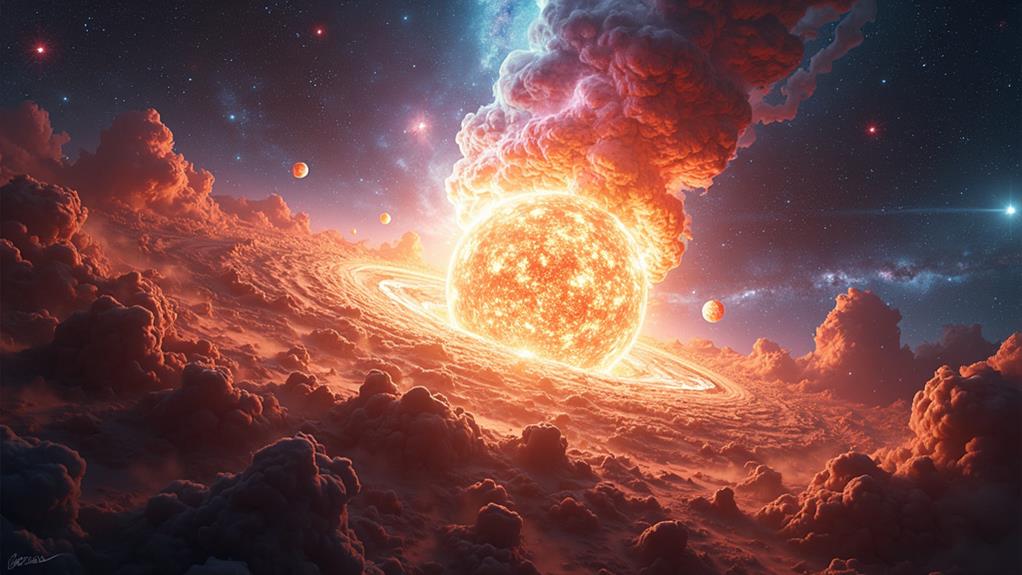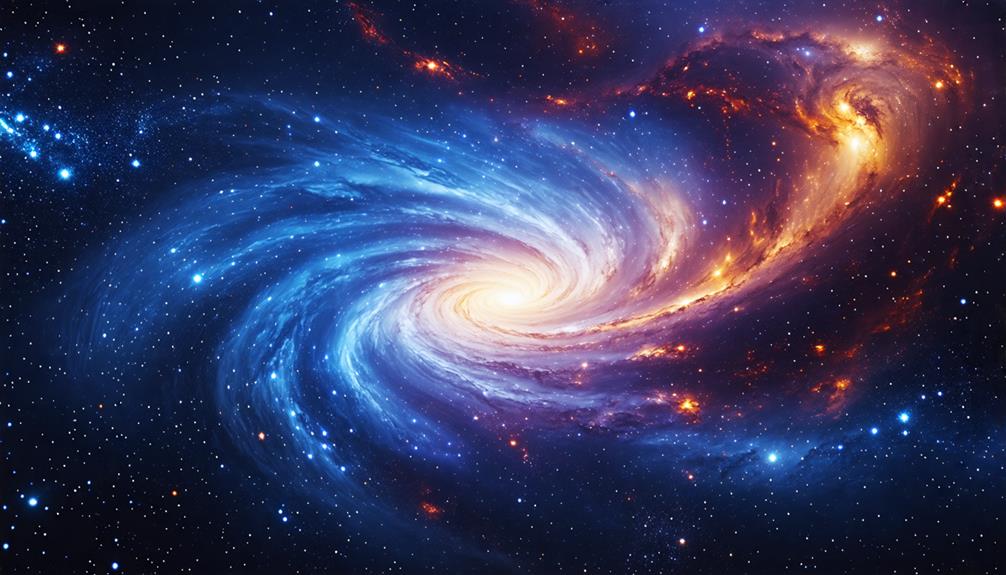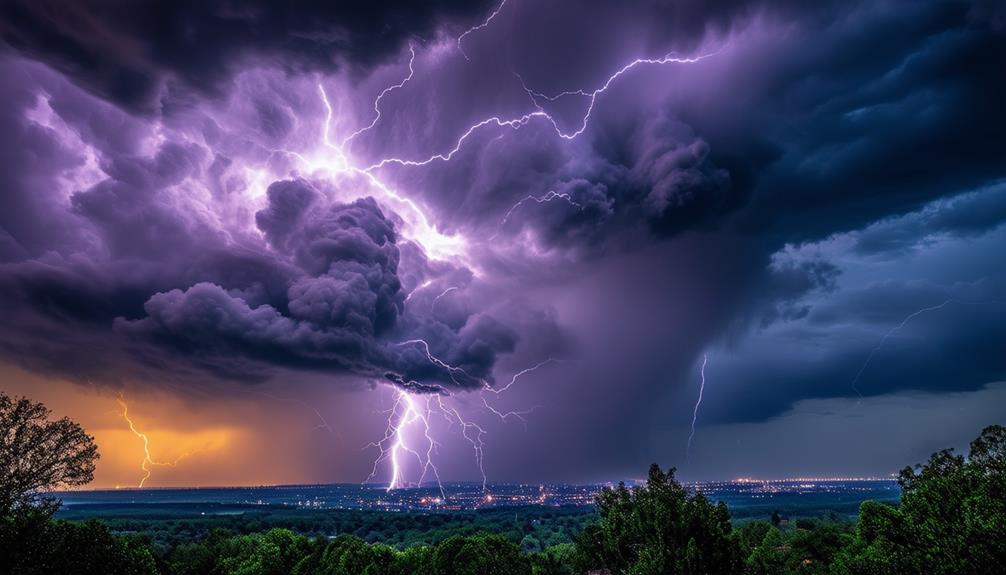Understanding Lava Flows on Enceladus
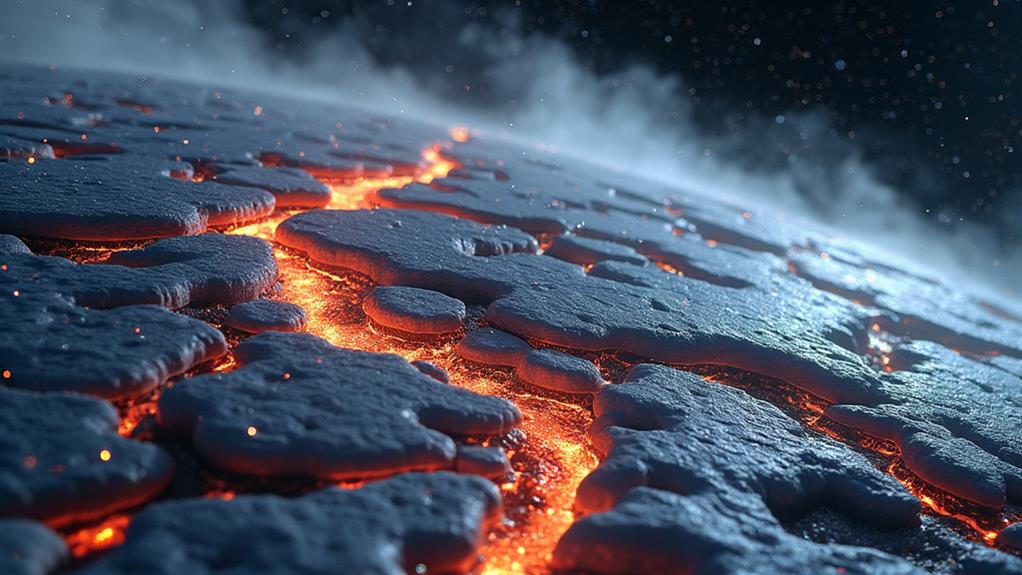
To grasp lava flows on Enceladus, understand cryovolcanism, where eruptions expel water ice and vapor from fissures at the south pole. The internal heat from tidal dissipation keeps a global ocean beneath the icy crust, facilitating these eruptions. Enceladus's geological features indicate active tectonic activity, with young rift-like structures and smooth plains formed by cryovolcanic processes, similar to Earth's flood-basalt regions. Materials ejected at supersonic speeds highlight its dynamic interior. These cryovolcanic activities also suggest possible hydrothermal zones, hinting at astrobiological potential. Continue to investigate how these fascinating processes shape Enceladus.
Key Takeaways
- Cryovolcanic eruptions on Enceladus expel volatile substances like ammonia and water, forming smooth plains similar to Earth's flood-basalts.
- Internal heat from tidal dissipation maintains a subsurface ocean, facilitating cryovolcanic lava flows.
- Eruptions at the south pole eject water ice and vapor at supersonic speeds, contributing to geological activity.
- Cryovolcanic activity shapes the surface with cratered domes and pit chains, indicating explosive volcanic processes.
- Variations in ice shell thickness suggest regions with potential for hydrothermal activity and nutrient-rich lava flows.
Cryovolcanism on Enceladus
Cryovolcanism on Enceladus is a fascinating phenomenon where water ice and vapor, instead of molten rock, are expelled into space from the moon's south pole fissures. These eruptions involve the ejection of ice particles and gas, contributing greatly to Saturn's E ring. With ice particles being expelled at tens of kg/sec and gas at ten times that rate, it's clear that Enceladus is geologically active.
The internal heat required for this activity is generated by tidal dissipation. Enceladus's elliptical orbit around Saturn causes tidal deformation, which maintains sufficient warmth to sustain a global ocean beneath its icy crust. This ocean plays an essential role in driving cryovolcanic eruptions.
Enceladus's icy crust is about 20 km thick, but it's much thinner at the south pole where eruptions are most pronounced. This thinner region allows for an easier escape of water and vapor due to density differences. During these eruptions, the materials reach supersonic speeds as they are expelled into space, showcasing the dynamic interplay between the global ocean and the icy shell. Cryovolcanism on Enceladus not only reveals the moon's internal heat but also its capability to support such dramatic geological processes.
Geological Features
When you look at Enceladus, its geological features immediately stand out, showcasing a world of dynamic and diverse processes. You'll notice ridged plains stretching over 500 km, a clear sign of significant tectonic activity and cryovolcanism. These plains, part of Enceladus' complex landscape, reveal the icy moon's active nature. The surface is a fascinating mix, with heavily cratered areas suggesting an ancient past and lightly cratered regions indicating ongoing geological processes.
As you investigate further, major lateral lithospheric motions become evident. These movements hint at active tectonic forces shaping the moon's surface, creating features like young rift-like structures. These structures, with few craters, suggest recent geological activity tied to cryovolcanic processes, where icy "lava" flows reshape the landscape.
One particularly intriguing feature is the labyrinthine ridge complex. This area appears to result from folding and convergence within Enceladus' lithosphere, shaped by internal dynamics and heat flow. Such features highlight the moon's active interior and the continuous interplay of tectonic activity and cryovolcanism that defines Enceladus, setting it apart from other icy moons in our solar system.
Tectonic Activity
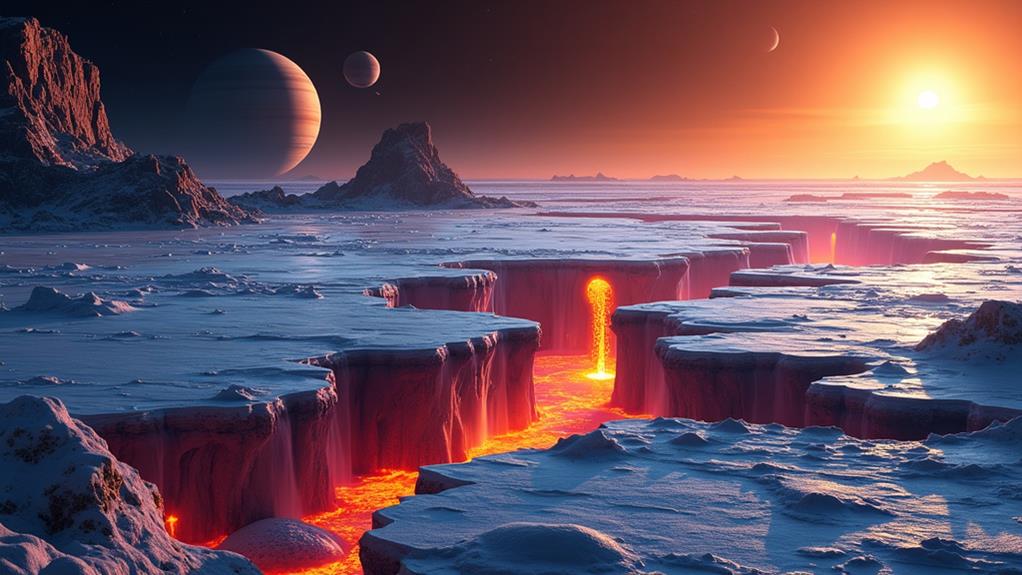
As you investigate Enceladus' surface further, the evident tectonic activity reveals itself as a key player in shaping this icy moon. You'll notice that the tectonic activity includes both extensional and compressional forces, indicating a complex geological history driven by subsurface processes. The ridge belts, with their impressive relief ranging from 500 to 2000 meters, offer clear evidence of dynamic crustal movements.
One striking feature is the Isbanir Fossa, a possible strike-slip fault with a significant 15 km offset. This suggests lateral motion within Enceladus' tectonic structure. Moving on to the cratered plains, you'll see that these areas are heavily cratered and dissected by extensional structures. These plains are a proof of the ongoing tectonic activity that continually reshapes the moon's surface.
The relatively young timeframe of the ridged plains, estimated to be between 107 to 108 years, further underscores the active geological processes at play. Enceladus' tectonic activity, encompassing extensional, compressional, and probable strike-slip faulting, paints a vivid picture of a moon constantly evolving through its internal and external forces.
Age and Formation
Understanding the timeframe and formation of Enceladus' surface is crucial for piecing together its geological history. Enceladus, one of Saturn's icy satellites, exhibits a fascinating mix of young and old terrains. The average lifespan of its ridged plains, estimated at between 10^7 to 10^8 years, suggests relatively young geological features. These smooth plains contrast with older, more cratered regions that likely date back to the early formation of the Saturnian system.
Young rift-like structures crisscross the surface and contain few craters, indicating recent geological activity. This points to ongoing processes that may include cryovolcanism, influenced by the moon's internal heat and potential liquid ocean beneath its icy crust. Cratered domes and pit chains on Enceladus suggest explosive volcanic activity, further shaping its dynamic topography.
Modified craters, affected by heat flow and geological relaxation, imply that Enceladus is far from geologically inactive. Understanding these formations helps you appreciate the moon's complex history and the ongoing forces at play. The interplay between ancient and recent features on Enceladus makes it a prime candidate for studying geological activity on icy satellites in our solar system.
Volcanic Processes
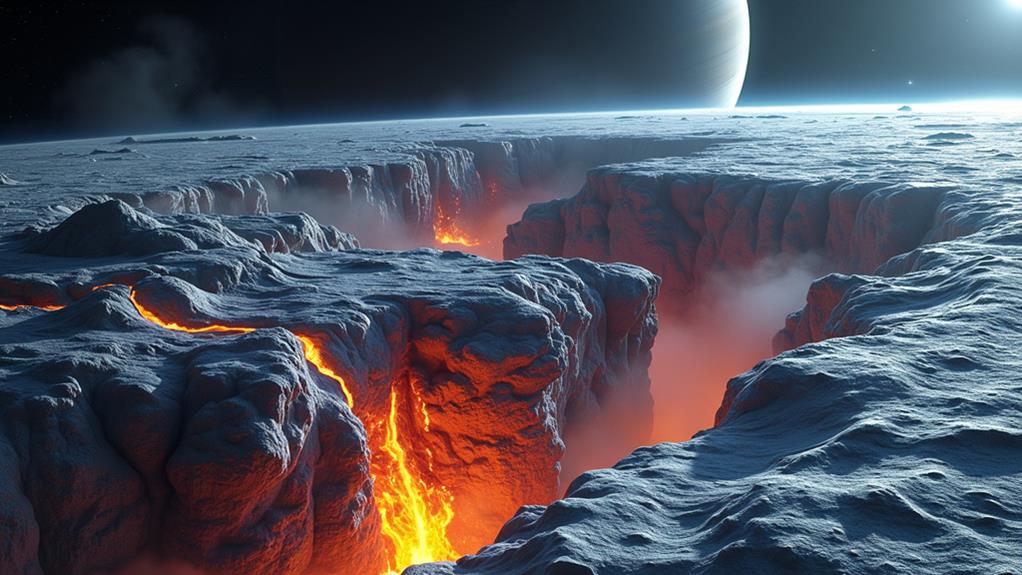
Volcanic processes on Enceladus are driven by fascinating cryovolcanic activity, which involves the eruption of volatile substances like ammonia and water rather than molten rock. These cryovolcanic eruptions have shaped the moon's surface, creating smooth plains that resemble flood-basalt formations on Earth. However, pure water isn't the sole cryovolcanic agent due to cosmochemical constraints. Instead, the presence of ammonia mixed with water (NH3-H2O) is a more plausible mechanism for these eruptions.
You see, the density relations of materials on Enceladus rule out eutectic brine lavas, pointing instead to ammonia-water volcanism. The current tidal dissipation processes on Enceladus likely cause the melting of ammonia hydrates or water ice, facilitating these cryovolcanic activities. When this mixture erupts, it forms cratered domes and pit chains observed on the surface, suggesting explosive volcanic activity.
These processes are essential for understanding the moon's geological history. The cryovolcanic eruptions, driven by internal heat and tidal forces, have continuously reshaped Enceladus' icy surface. By studying these cryovolcanic activities, you gain a deeper insight into the dynamic nature of Enceladus' volcanism and its ongoing development.
Implications for Astrobiology
The cryovolcanic processes on Enceladus don't just shape its surface; they also open doors to possible life beyond Earth. When you investigate Enceladus, you'll find that its cryovolcanic activity points to a subsurface ocean beneath the icy crust. This ocean, revealed by eruptions of water vapor and ice particles, is a potential habitat for life. The presence of salts and silica nanoparticles in the ejected materials suggests that this ocean interacts with a rocky core, providing vital nutrients that could sustain microbial life.
Active geysers at the south pole release not only water vapor but also organic compounds. These compounds are significant indicators in astrobiological studies, as they form the building blocks of life. The variability in the ice shell thickness, averaging around 20 km, hints at regions within the ocean where hydrothermal activity might occur. Such hydrothermal vents could create chemically diverse environments, ideal for life to thrive.
Future missions, like the proposed Enceladus Orbilander, aim to analyze these plumes for biosignatures. By studying the materials ejected from these geysers, you can better understand the moon's habitability and the broader implications for life beyond our planet.
Frequently Asked Questions
What Was the Evidence for Cryovolcanism on Enceladus?
Imagine the geyser plumes on Enceladus as celestial fireworks. You see cryovolcanic activity through these plumes, detected by Cassini's spectral analysis. The surface features, like fissures, hint at ice tectonics, while heat sources suggest a dynamic interior. Geological history and the revelation of a subsurface ocean also point to ongoing activity. This evidence paints a vivid picture of Enceladus' active, icy world.
What Causes Tidal Heating on Enceladus?
You're wondering what causes tidal heating on Enceladus. It's the result of tidal forces from Saturn's gravitational interaction and the moon's orbital resonance. These forces lead to internal heating by continuously stretching and compressing Enceladus' ice shell. This heat generation prevents complete freezing, enabling geological activity and cryogenic processes. Fundamentally, the dynamic gravitational pull keeps the subsurface ocean warm enough for these fascinating phenomena.
What Are Lava Flows on the Moon?
Imagine the moon's surface as a painter's canvas, where volcanic activity has splashed incredible surface features. Moon geology reveals that volcanic activity here differs from Earth. Lava flows result from planetary volcanism, involving basaltic lava. Unlike Enceladus' icy crust and cryovolcanic processes, the moon's eruptions involve molten rock. These eruptions create distinct lava plains, ridges, and valleys, showcasing unique eruption mechanisms and diverse lava composition.
Why Scientists Know There Is an Ocean on Enceladus?
You know there's an ocean on Enceladus because of its oceanic composition and subsurface geology. Gravitational interactions and thermal dynamics keep the ocean liquid beneath the ice crust. Surface features like active geysers and exploration missions reveal materials indicating a dynamic ocean. Cassini's data showed significant ice particle ejections, suggesting an ocean with astrobiological potential. All these clues confirm the presence of a subsurface ocean.

